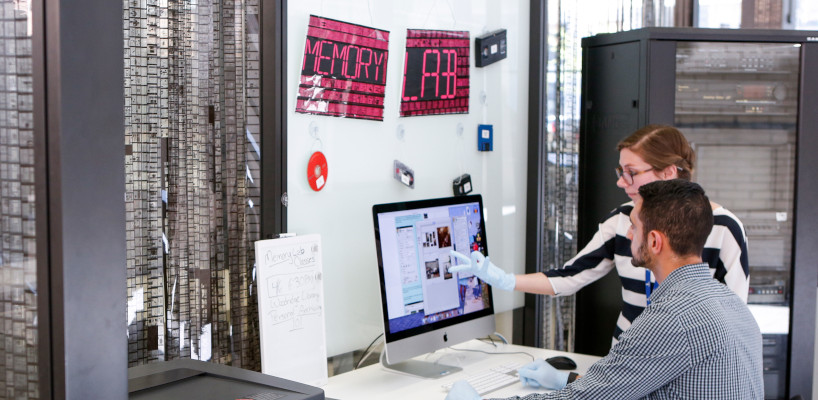At a participatory archiving event, Contributors bring Items in a variety of formats--from tintypes to born-digital photographs--to include in the collection. At the Copying Station, it is essential to make the best digital copy possible and to name the file precisely to match the Item ID Number on the Descriptive Information Form. While copying items can be straightforward, accuracy is critical to avoid the danger of overwriting files or losing copies.
Roles & Responsibilities
For an overview of all RoPA Roles and Responsibilities, please review the Building a Team module.
The Event Coordinator will work with the Collection Coordinator and the Copying Station Captain to make sure that the appropriate equipment (computers, scanners, etc.), supplies, and paperwork, including workflows for copying items, are available at the Copying Station on the day of the event.
The Collection Coordinator will designate a Copying Station Captain and will work with that individual to make sure the Copying Station Volunteers are properly trained to employ the Numbering System and to digitize and copy Items at the event. The Collection Coordinator will also need to be available during the event to help address any questions or concerns that may arise related to the digitization and copying process.
Designated by the Collection Coordinator, the Copying Station Captain will oversee all preparation, volunteer training, and day-of-event activities related to the Copying Station. The Copying Station Captain should be very comfortable with technology and with leading a group of people with differing levels of technological experience.
The RoPA Developers recommend that the Copying Station Captain be a library, museum, or cultural organization staff member who is familiar with digitization, computers, and technology.
You will need six volunteers at three tables to work the Copying Station. Very large events (150+ people) may need eight volunteers at four tables; for very small events (less than 25 people) four volunteers at two tables may be sufficient. Each table has two volunteers: one Item Copier and one Reviewer. The Item Copier handles data entry and scanning. They should have experience using a scanner, scanning software, cropping images, and renaming and saving files to a computer. The Reviewer manages paperwork and signs off on the Descriptive Information Form. The Reviewer should be detail-oriented to ensure forms are complete and legible.
While these two roles have different specific responsibilities, they are both essential for accurately capturing and storing data about Items and Contributors. Teamwork is especially important because the two roles are closely intertwined, as the main goal is to copy Items that match up precisely with the paperwork.
Designated by the Collection Coordinator, the Digital Preservation Specialist will provide the Collection Coordinator and the Copying Station Captain with the Event Email Address (which will need to be added to the Workflow for Email Items. The Digital Preservation Specialist will also conduct both mid-day and end-of-day backups of files on the Copying Station computers and will be responsible for gathering and storing all Descriptive Information Forms at the end of event.
Steps to Success
Download a Quick Checklist of the Copying Items steps here.
Best Practice Examples
Do you know of a project or program that could be featured here? Please contact us.
Resources
The Culture in Transit Toolkit includes a number of recommendations for digitization equipment, including a Copy Stand Kit List for digitizing oversize two-dimensional and three-dimensional objects.
The DC Public Library Memory Lab was created, in part, to provide replicable models and approaches for digitization and personal digital archiving. Their website includes a range of digitization workflows.
The Maine Memory Network, a project of the Maine Historical Society, provides access to thousands of historical items belonging to over 270 organizations from across Maine. They provide a list of recommended equipment and software for participating in their Maine Memory Network digitization program
RoPA recommendations and guidelines for scanning equipment and software.
Glossary
Information or objects originate in nondigital formats, and include objects like paper and physical photographs. (Adapted from Dictionary of Archives Terminology, Society of American Archivists.)
Information or objects originate in a computer environment, and include objects that were created using a word processor or a digital camera. (Adapted from Dictionary of Archives Terminology, Society of American Archivists.)
A digital copy of a record on any analog medium, such as paper or a physical photograph. (Adapted from Dictionary of Archives Terminology, Society of American Archivists.)
Equipment used to create digital images of photographs and documents that are placed on a stationary glass platen, or scanning bed. A scanner may be used to capture pictures or text. (Adapted from Dictionary of Archives Terminology, Society of American Archivists.)
The measure of sharpness or detail in an image. Resolution quality depends on a number of factors, and is often measured using DPI (or Dots Per Inch). (Adapted from Dictionary of Archives Terminology, Society of American Archivists.)
